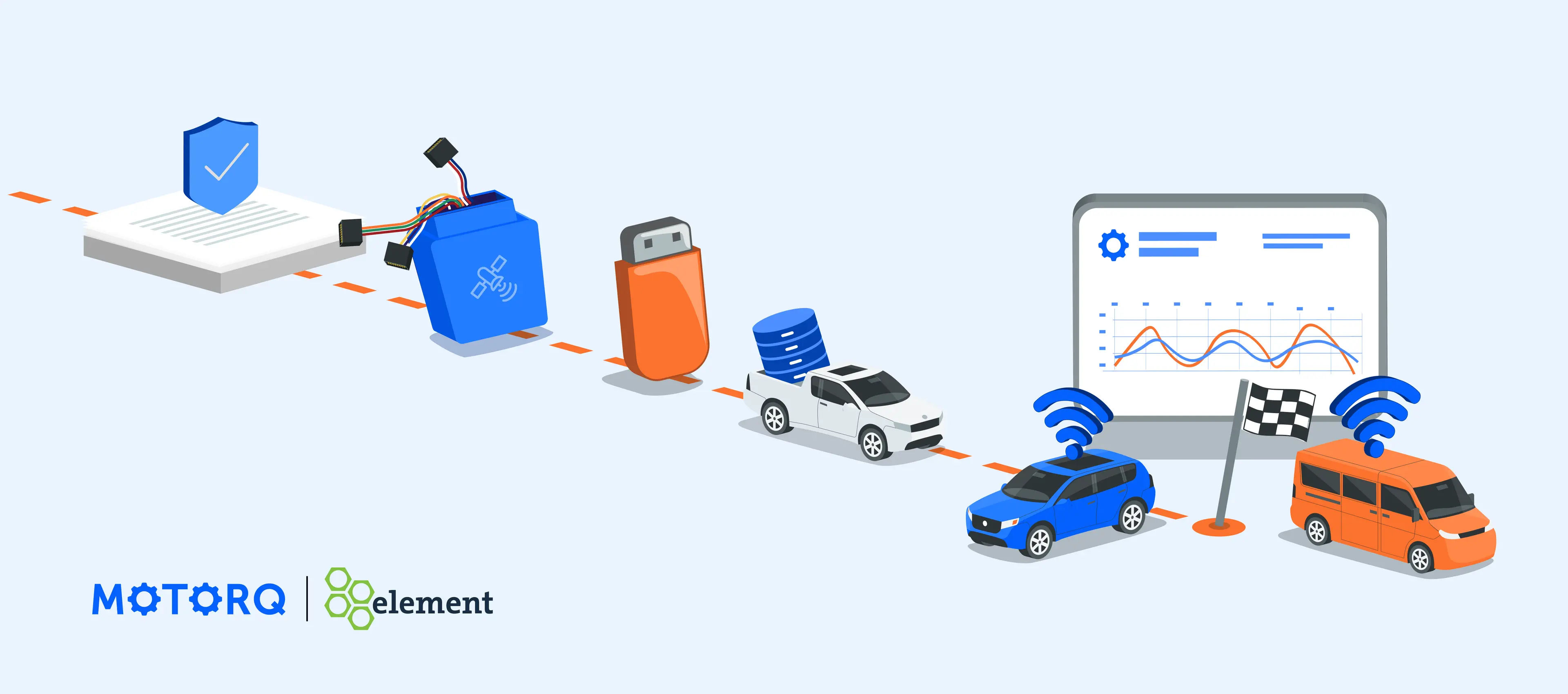Vehicle Data's Next Era: Data Comes Standard

There's a paradigm shift happening in vehicle data, the third such shift in the last 20 years. To put it in the historical context it deserves, here's...
An Exceedingly Brief History of Vehicle Data
Telematics was invented 45 years ago, but starting about 25 years ago, vehicle information started to truly change. This timeline abbreviates our already abbreviated history of data — mapping out the key turning stages along the way.
Each phase deserves its own post, but for now, let's dive into the evolution of vehicle data, starting with...
The "Dongle" Phase
There are a few places we could start, but we'll begin just before the founding of a little family business called Geotab.
In the late 1990's, European and North American governments started paying attention to safety and efficiency on their major roadways. Leaders on both sides of the Atlantic signed policy directives allowing the development of GPS tracking and logging devices (originally limited to military use) for civilian use.
Geotab was founded in 2000 to develop a tracking and logging device, and in 2003, they released one, ushering in the aftermarket device phase of vehicle data, also known as "The Dongle" phase.
Fleets could access tracking and logging data by purchasing physical dongles and plugging them into the onboard diagnostics port of their cars. This level of data availability worked well in the early 2000's as electronic logging devices (ELDs) proliferated.
The “Data as Upgrade” Phase
Fast-forward a little bit to the year 2018. By this time, several automakers (or OEMs, for Original Equipment Manufacturers) had begun to ship vehicles with built-in modems. GM was early with OnStar, one of the first products to connect vehicle navigation services to the internet. But these "connected-capable" vehicles and their onboard modems didn't become widespread until around 2018, the first year of the "Data as Upgrade" phase.
This phase is marked by improved quality and reliability in the data streams. Dongles generated inferred, third-party data and were often knocked out or removed by drivers. Those problems disappeared with OEM data flowing from the built-in modems.
Fleets could finally access OEM-quality data directly from the vehicles themselves, but they'd have to pay for the privilege.
In their fleet management contract or OEM contract or OnStar license, vehicle data access was a feature of an upgraded package, like leather seats or a lift kit. Hence the name "Data as Upgrade."
Today: the “Data as Standard Equipment” Phase
At the time of writing, it is now 2023, and we are entering the "standard equipment" phase of vehicle data.
What is standard equipment?
Per title 49, subtitle VI, part C, chapter 331 of the U.S. Code, the codification of the general and permanent laws of the United States, standard equipment is defined as "equipment already installed in a motor vehicle when it is delivered from the manufacturer and not an accessory or other item that the first purchaser customarily has the option to have installed."
It's the stuff that comes standard!
Just like the modem, access to the data emitted by fleet vehicles now just comes with the vehicle, like the tires and the cupholders and the back-up camera.
What does standard data look like in the market? For Element Fleet Management, the second-largest fleet manager (and only publicly-traded one) in North America, it looks like Base Connectivity, a basic data package that surfaces insights both to end customers (to optimize fleet ops) and to Element (to better manage the fleets in their care).

Other fleet management companies are following suit by including data terms in their standard contracts. And this industry-wide shift makes sense. Fleet management companies are in the business of... well, managing fleets; connected fleets operate more safely, more reliably, and more efficiently as a result of the insights from the vehicles. It makes sense for fleet management companies to take advantage of readily available data to better serve their customers.
Adoption of EVs is also accelerating the adoption of data as standard equipment.
The electrification of North American fleets has presented the fleet management industry with an opportunity (some would say a mandate) to innovate. As more and more fleets adopt electric vehicles, fleet managers require connected data to collapse the additional complexity (charging, home reimbursement, battery health) that EVs add to the fleet equation.
Looking Ahead
In the vehicle data space, power and agency are shifting downstream, that is, shifting from data providers to fleet owners and operators. With data flowing from practically every vehicle, the winners will be those who use it to inform both fleet decisions and business decisions.
In the "Dongle Phase," every part of the data experience was locked down: the dongle was a black box (often literally) that output the data in fixed formats. One company could control the entire flow, from source to logic to output.
The availability of OEM data in the "Data as Upgrade" changed the game by presenting new connectivity opportunities... and challenges. Parsing data from multiple OEMs is a much more difficult technical problem than parsing data from a single device.
In the "Data as Standard Equipment" phase, we're seeing a decoupling of sources from outputs.
Customers rightfully expect more than a static experience; they are demanding integration of inputs and harmonization of output, not only into fleet applications but into the business applications they already use to make decisions.
Customers rightfully expect more than a static experience; they are demanding integration of inputs and harmonization of output, not only into fleet applications but into the business applications they already use to make decisions.
If you're leasing or purchasing new vehicles, you'll still have to decide on the trim, the maintenance package, and the financing. But the data that'll help you and your FMC get the most return on your investment?
That data comes standard.